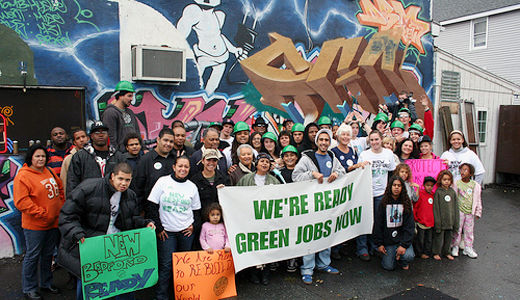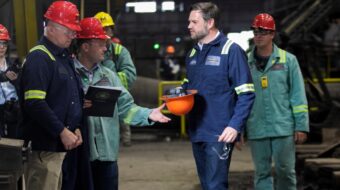
A ringing call for a new militant Civil Rights movement “2.0” centered on the fight for jobs was recently made by leaders of the United Steelworkers, Leo W. Gerard and Fred Redmond.
“It’s time to stand up and be heard,” they said. “It’s time to mobilize online and in the streets. Together, let’s tweet, facebook and text. Let’s rally, vote and, where necessary, sit-in.”
The 50th anniversary of the “Greensboro Four,” when Black college students ignited a movement challenging racial segregation and injustice in the South, served as shining example for the labor leaders.
“The involvement of young people in that movement – along with religious, labor and other community leaders – cannot be underestimated,” they noted. “They forced America to change for the better, to change for them.”
Five decades later, “it’s time for America’s youth to lead another revolution, one that forces the nation to solve the critical civil rights challenge of this time.” This challenge is jobs.
The labor leaders pointed to the unique problems facing young people. Of the more than 46 million uninsured Americans, 13.2 million are young adults – the fastest growing segment of citizens without health benefits. One-third of Latinos and one-fifth of blacks are uninsured compared to 13 percent of whites.
The official unemployment rate nationwide is nearly 10 percent and 20 million workers ages 16 to 24 were jobless in 2009. That’s more than 50 percent of all people in that age group, union leaders note. And unemployment rates for Blacks and Latinos are twice as high.
“It’s time for a revolution,” they said.
Leaders of the civil rights movement knew good jobs provided a pathway to a better life and they knew that justice wasn’t going to happen without coordinated, sustained and organized action, noted Gerard and Redmond.
Gerard and Redmond said young people today must have the same opportunities as prior generations, laying stress on the manufacturing industry, the “great equalizer” for America.
“We’re talking about new, high tech, clean, efficient and world-class manufacturing. The making of wind turbines and solar panels to power the clean energy industry; hybrid and electric cars, components for iPhones, laptop computers and other electronics; materials for energy-efficient office buildings, homes and roads. Parts needed for high-speed rail, modern schools, updated water lines, sewer systems and other infrastructure that’s costing us money and precious time in the fight against global warming.”
Gerard and Redmond note every manufacturing job supports five more jobs, compared to just one job supported by a service sector position.
Such jobs pay an average 10 to 50 percent more than service sector jobs.
Creating 2.5 million new manufacturing jobs would mean at least $100 billion for the American economy over the next decade.
Most union workers earn more than nonunion workers and more importantly they share a voice on the job when it comes to health care, stronger safety and health protections and retirement security.
If Wall Street shareholders are entitled to a share of profits, then the hard working employees who help businesses thrive should also get their fair share too, they charge.
The Steelworker leaders are calling on young people to lead the way.
“Imagine the opportunities. Think about the difference in your lives, in your communities. America needs you in this fight, and you need to be in this fight,” they said.
“Let’s begin a revolution.”
Photo: http://www.flickr.com/photos/green4all/ / CC BY 2.0










